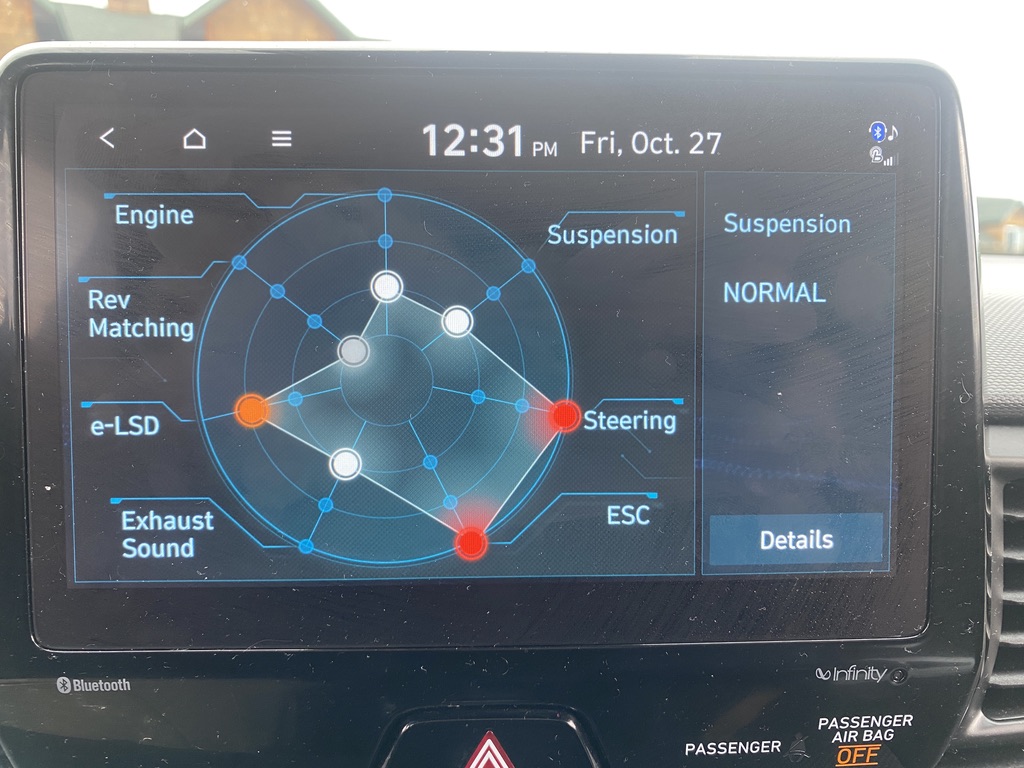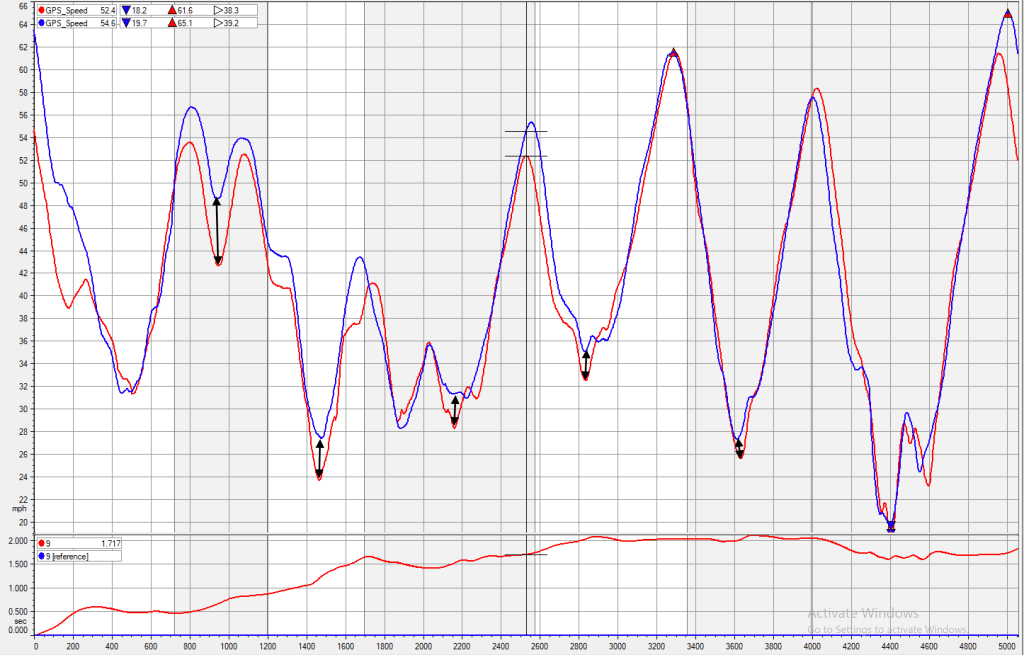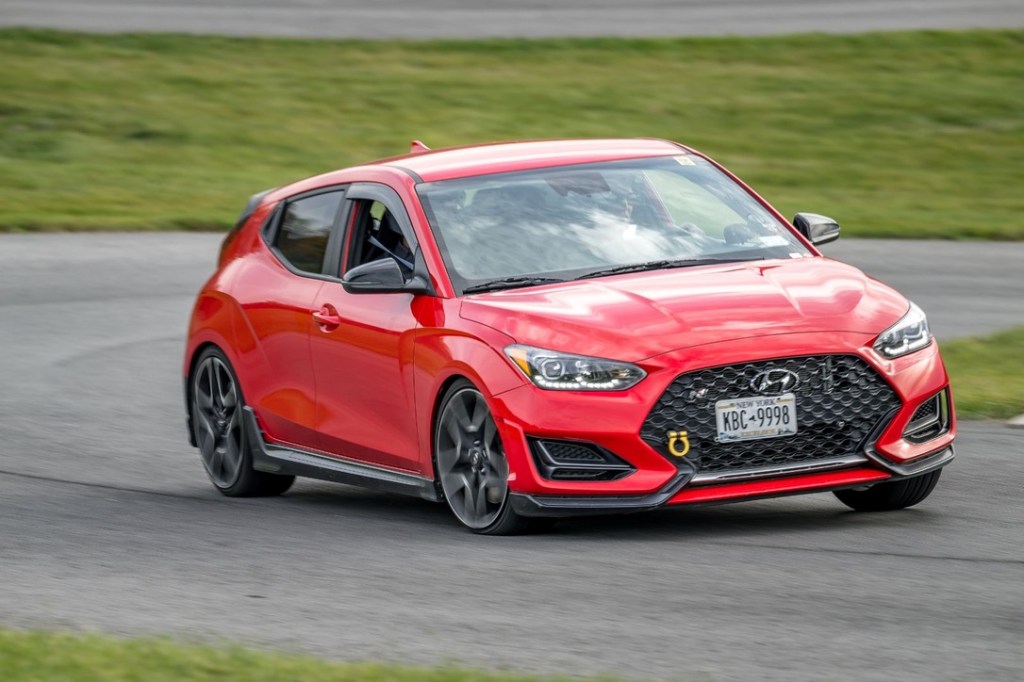The Veloster N has five driving modes: Economy, Normal, Sport, N, and N Custom. Er… I think I have this right, I don’t know, because I only use two.
- Eco – Economy mode limits boost pressure, but from what I’ve read online, it’s not any more economical. So I don’t use this.
- Normal – I use Normal mode on the street.
- Sport – I’ve never tried this, I don’t see the point.
- N – I don’t use this, the suspension is too hard, and the pops and bangs of a burble tune annoy this shit out of me.
- N Custom – I use this mode on track. I have the eLSD and steering on full, but pretty much everything else is turned off or on the lowest setting. No rev matching, soft suspension, no stability control, and the exhaust as quiet as it’ll go. For some unknown reason, I’ve also had the engine in the lowest setting all year, which should be a nice surprise when I select full power next year (actually, I later found out there’s no difference in peak output).

I’ve driven my VN on track in both wet and dry conditions, and on good and bad tires. Now that I’ve had a chance to look at some comparative track data, I can answer some questions, such as:
- Which driving mode is fastest on a wet track?
- Which driving mode is fastest on a dry track?
- How do all-season tires compare to a proper track tire?
Dry track: Normal vs N Custom
Since I only use the Normal and N Custom modes, I wanted to see how they compared on a dry track. My N Custom mode was 1.9 seconds faster. Woof.
Subjectively, the Normal mode sucks ass on the track. It takes the fun out of driving. The stability control is probably the main culprit, and switching to the N mode (on the fly) resulted in instant smiles from me and a “whoa” from my passenger. The way the car behaves is night and day different in N Custom mode. It’s astonishing.
This immediately changed the way I drove, from trying to maintain a higher vMin, to backing up the corner. I don’t mean to throw jargon at you, so let’s take a look at the data and I’ll explain those terms. I’ve highlighted the the three most significant differences with letters.

- This is Turn 2, a right hand turn onto a short straight. You can see that the Red line has about 2 mph higher minimum speed (vMin), but when I get on the gas, the nannies nerf the acceleration and I only get .31 Gs of acceleration. The Blue line has .5 Gs of acceleration, which results in about a .4 second gain. This is entirely down to the car’s intelligent systems getting in the way of my driving.
- This is T9, another right hander, this one cresting a hill. By turning off the nannies I can rotate the car, which allows me to get on the gas 95 feet earlier than in Normal mode. We call this “backing up the corner,” and it means that I’ve done my braking and turning earlier in the corner. This allows me to get to full throttle earlier, and gains half a second.
- Notice here how the Blue lines are to the left of the Red lines, again this is backing up the corner, and doing that in the final turn is worth almost three quarters of a second as I cross the finish line.
What’s really interesting about this graphic is that I had no idea I was in Normal mode at first. I was driving with a passenger, chatting, and totally forgot to switch modes. Then suddenly I realized I hadn’t changed the driving mode. The Veloster N allows you to do this on the fly, and so part way through the lap I switched modes.
This allowed me to drive the car in a completely different manner. I could immediately feel the difference in the way the car behaved, and was able to extract a higher level of performance, and go 1.9 seconds faster. But I wasn’t aware of how differently I was driving the car until I looked at the data just now.
Wet track: Normal vs N Custom
I also got to try both modes on a cold, wet day. This was the same track with a slightly different configuration to avoid one of the big puddles. It was raining the entire time, and there was a lot of standing water on the track.
In N Custom mode, I spun the wheels a lot on acceleration, and had to short shift to third in a number of places. My best lap was a 1:28.838. In Normal mode, I managed a 1:28.592, but was still getting some wheel spin cresting a hill. So then I left it in third gear and did a 1:26.994. That’s a difference of 1.84 seconds, which is almost exactly the same difference the two modes had in the dry.
So that’s the ticket to going fast in a torrential downpour, put it in Normal mode and drive a gear taller.
The data below isn’t super exciting, the thing to notice is mostly the difference in vMin (or minimum corner speed). I’ve drawn little black arrows to show what I mean. When the nannies are on, I can maintain a higher speed in the middle of the corner, and this results in a faster speed down the next straight. The acceleration curves are about the same in N Custom and Normal, which I find a little surprising, and so I suspect that it’s the stability control more than the traction control that’s helping in the rain.

All-season vs track tires
I have three sets of wheels and tires: 235/40R18 Kumho V730 on Konig Countergram 18×8.5 +43 (42.3 lbs); Pirelli PZ4 235/40R18 on Motegi MR140 18×8.5 +45, (42.0 lbs) and Linglong Crosswind 235/35R19 all-season tires on 19×8 +55 OEM wheels (55.3 lbs).
The only reason I bought the Crosswind tires was because the OEM tires were worn out, and I was looking for the cheapest possible tire I could mount in the winter, while my summer tires are hibernating in a heated basement. I found the Crosswind tires on sale for $65 at Walmart, and expected absolutely nothing from them.
Just the same, I wanted to see what they would do on track, and I’ve been pleasantly supersized. They don’t suck. Because there’s not a lot of grip, they break away gradually, and slides are easy to control. Once sideways, the tires howl like a banshee, which helps you know how much you’re working the tires. Or overworking.

I haven’t tested the Crosswinds back to back with the V730, but I put down a 1:19.1 on the all-seasons, which is about 2 seconds slower than the Kumhos did on a previous occasion. This is surprising, because you’d expect the 200TW to be a lot faster than 400TW. For example, my 1.6 Miata is about 6 seconds faster on RS4s than it is on all-season tires. This all fits in with previous data I hand that shows that FWD cars lose less performance in low-grip situations (such as rain, dirt, snow, or shitty tires).

All said, I’m having Miata-levels of fun on these $65 tires. Had I known this was possible, I wouldn’t have three sets of wheels. With a better all-season tire, like a Michelin Pilot Sport A/S 4, I think you could do everything from daily commuting to track days on one set of wheels. I know a lot of people feel they need track tires for track driving, I’m just not one of them.